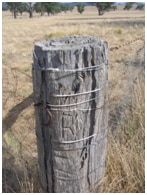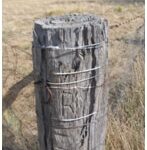Doherty Smith & Associates is now Compass Consulting Surveyors
Click here to see this blog and more on our new website compasscs.com.au
 Surveyors are often called in to resolve disputes between neighbours in regard to dividing fences. A dividing fence can be a structure of almost any material that separates the lands of adjoining owners. A dividing fence does not include a retaining wall or the wall of a building.
Surveyors are often called in to resolve disputes between neighbours in regard to dividing fences. A dividing fence can be a structure of almost any material that separates the lands of adjoining owners. A dividing fence does not include a retaining wall or the wall of a building.
Where should the fence go? A dividing fence should technically go on the boundary line between two parcels of land. In some cases, such as rural boundaries in rough country, agreements have been made between owners to have a “give and take” fence, which follows a line that is easier to construct and maintain. In urban areas, the location of dividing fences becomes more important due to the higher value per square metre of land.
Adjoining owners must share the cost of a dividing fence except that:
- An owner must pay additional cost if they want a fence of higher standard than is required for a “sufficient” dividing fence
- An owner will have to pay the full cost if the existing fence is damaged, either deliberately or negligently, by the owner of someone else with the owner’s permission. If the fence is damaged by a tenant, the owner must pay for the work even if they plan to claim the cost from the tenant.
- Public authorities with control over crown lands, parks, reserves, etc do not have to contribute to fencing costs. People living next to such properties may be able to negotiate with the authority for a contribution.
A “sufficient” dividing fence is a fence that adequately separates the properties, in keeping with the fences considered to be usual in the locality. Residential fences may include metal “Colorbond” style fences, while rural fences may include barbed wire, plain wire and hinge-joint with metal star posts.
If an owner wants an adjoining owner to share in the cost of a dividing fence, the must serve a fencing notice on the adjoining owner before any fencing work is commenced. Owners must share in the cost once agreement is reached.
A fencing notice is not needed in a case where a dividing fence has been destroyed or damaged, resulting in the need for urgent fencing work for safety reasons, security reasons or to prevent stock loss. In this situation, owners must share the cost equally.
If agreement to share costs between adjoining owners is not reached, they may attend a Community Justice Centre or, if agreement is still not reached, a Local Court or Local Land Board.
The cost of a dividing fence includes the cost of all related fencing work such as design, construction, replacement, repair and maintenance of the fence.
If the owners do not agree on the position of the common “boundary line” for the purpose of fencing work, an owner may give notice in writing to the other owner of their intention to have the common boundary line defined by a registered surveyor.
The height of fencing is regulated by Councils and in some cases, fences or other structures may require development consent. Contact your local Council with any queries relating to the height or actual construction of dividing fences.
Further information on dividing fences can be found in the Dividing Fences Act 1991 and through the Land & Property Management Authority NSW Website here.



